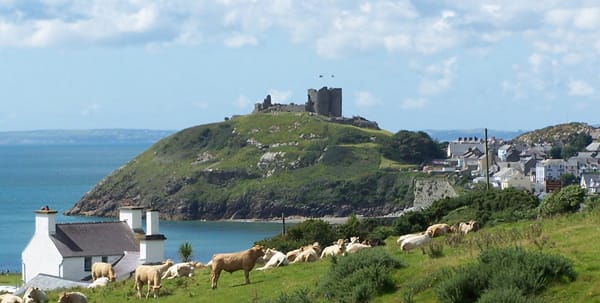
As a youngster growing up, many family vacations were spent in Wales. A country of amazing culture, history, sights and countryside especially in the North where we visited frequently.

The view of Mount Snowdown, from the village of Capel Curig
Wales is located on a peninsula in central-west Great Britain. It is about the size of Massachusetts. It has a population estimated at three million and is officially bilingual, with both Welsh and English having equal status. Originally (and traditionally) a Celtic land and one of the Celtic nations. Both languages are widely spoken, Welsh being particularly strong, and sometimes the only language spoken, in the Northern towns and villages. Case in point, I worked with a chef here in Toronto who came from a small village called Capel Curig in Snowdonia. Up until the age of 8 this chef spoke only Welsh and only started to learn English in school in 3rd grade. The view from his village looks out towards the peaks of Mount Snowdon. Wherever possible I will provide both English and Welsh pronunciations.
The main population and industrial areas are in South Wales. Heavy industry like coal mining and ship building were once situated here around the cities of Cardiff (Caerdydd), Swansea (Abertawe), Newport (Casnewydd) and surrounding areas, with another significant population in the north-east around Wrexham. We used to visit mid country and North Wales which is not as densely populated as the south, and has lots of farming and cottage industries.

Caernarfon
Much of Wales’s diverse landscape is mountainous, particularly in the north and central regions. The mountains were shaped during the last ice age. The highest mountains in Wales are in Snowdonia (Eryri), and include Snowdon (Yr Wyddfa), which, at 1085 m (3,560 ft) is the highest peak in Wales. The 14 (or possibly 15) Welsh mountains over 3,000 feet (914 m) high are known collectively as the Welsh 3000s, and are located in a small area in the north-west.
The capital, Cardiff (Caerdydd), is Wales’s largest city with 317,500 people. For a period it was the biggest coal port in the world and, for a few years before World War One, handled a greater tonnage of cargo than either London or Liverpool. One of my clients here in Toronto, Mrs. Julia Koschitzky and her sister Jeanette, were born in Cardiff as her family escaped the turmoil of Poland and Germany en route to a new life in North America.

Welsh flag
Even today there is still a Jewish existence in Wales, centered around Cardiff. Major Jewish settlement in Wales dates from the 19th century, although there are records of Jewish communities from the 18th century as well. The modern community in South Wales is centered around the Cardiff Reform Synagogue and the Cardiff United Synagogue. The oldest non-Christian faith [in Wales] to be established was Judaism, with a presence in Swansea dating from around 1730. Jewish communities were formed in the next century in Cardiff, Merthyr Tydfil, Pontypridd and Tredegar.

Dolgellau
We spent many hours visiting small towns and the many castles of North Wales. Sometimes said to be “the castle capital of the world”, Wales had about 400 castles, of which over 100 are still standing, either as ruins or as restored buildings. It is home to some of Europe’s finest surviving examples of medieval castle construction; most were built in the 12th and 13th century and are still today are fine examples of early craftsmanship.
Caernarfon Castle is where the investiture of Prince Charles took place 40 years ago, on June 28, 1969 as he was bestowed the title “Prince of Wales” by the Queen.

Barmouth
The Dragon on the Welsh flag is thought to have been left from the Roman times, as this was a widely used symbol by the Romans.
My favourite town was Dolgellau, which is a small market town situated between 3 mountainous areas which house three hill forts of uncertain origin, but thought to be from the Roman period.
Another favourite was the seaside town of Barmouth, on the west coast. Although the water was always cold we still swam on a regular basis, crazy as it was! It was there my family was vacationing on 16 August 1977. I remember picking up the morning paper for my parents and the headlines screaming of Elvis’ death.
Welsh cuisine is not world renowned, but is moderately famous for its Spring Lamb, and leeks, which are its National Emblem.
The words of this author reflect his/her own opinions and do not necessarily represent the official position of the Orthodox Union.
